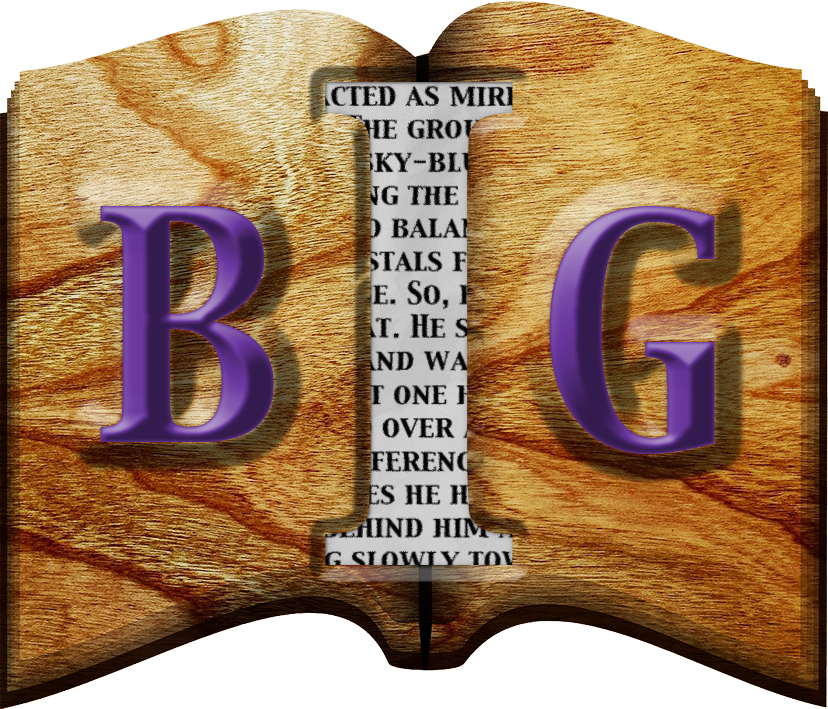At a Glance: Clank! A Deck-Building Adventure
Designer: Paul Dennon
Publisher: Renegade Game Studios
Artists: Rayph Beisner, Raul Ramos, Nate Storm
Player Count: 1-4
Suggested Age: 14+ (8+ by BGG community)
Playing Time: 60 minutes
Theme: Fantasy, adventure
Mechanics: Deck building, push your luck, pickup and deliver
Let the Dragon ride again on the winds of time.
– Robert Jordan
Intro Story: The Dragon Horde Trials
Carl walked on the the long, green grass of the abandoned castle’s courtyard before entering a torch-lit passageway that stretched underneath the castle, leading toward the dragon’s lair, and, by association, the dragon’s treasure. He hadn’t been in the labyrinthine tunnels long before he saw evidence of the dragon’s presence: claw marks in the stone walls and floor (if the dragon could leave marks like those in stone, then what of a man’s flesh?), charred skeletons of previous victims who were so close to the surface (yet obviously not close enough), and discarded weapons (dragons don’t eat swords).
And still Carl’s broad smile stayed glued to his face. Above all odds, he had been invited to take part in the annual Dragon Horde Trials, put on by the illustrious Underground Thief Network (or UTN, as it was known among burglars).
With more pride than a deep well filled with water, Carl took off running after the other three contestants into the castle’s “hidden” passage below the cellars and prison cells. True, the three other participants were much faster than him—as laid most obvious by their leaving him out of sight within the first few minutes of the Trial—and most likely stronger, but Carl could do anything he put his mind to.
Carl slipped and fell down a steep slope, landing with an echoed thud in a vast, crystal cavern. The crystals shone a light blue hue, giving off a faint light by which to see. He looked around, eyes shimmering with greed.
The crystals acted as mirrors, reflecting his image everywhere he looked. The ground, ceiling, columns, and walls all consisted of these sky-blue crystals. He took a step and fell over, vertigo getting the best of him. He stood up slowly, but found it difficult to balance. Moving carefully, he tried to free one of the crystals from its nest in the cavern.
It wouldn’t budge. So, he moved to another crystal. And another one after that. He strained to pull up the crystals in the floor, ceiling, and walls, but they wouldn’t budge. He pulled at every last one he could find, but found no luck. He heard a guttural grunt behind him and turned around.
There, ambling slowly toward him with a menacing look was a massive creature—a golem, Carl realized—made entirely from crystals.
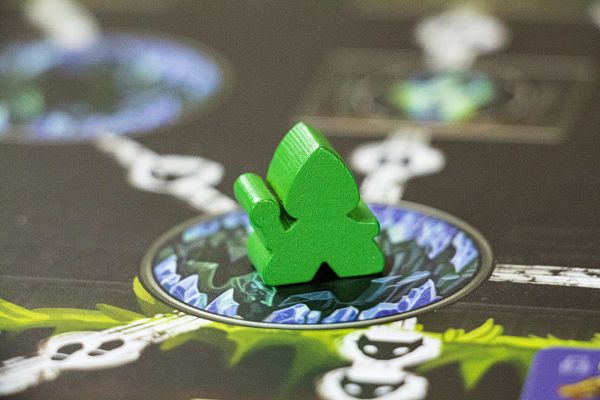
Review Map
This review has two parts. First, there is the Short Review, where various aspects of the game are discussed. Then comes the Gameplay Review, in which the setup and gameplay are discussed in detail, along with initial thoughts. Following the Gameplay Review section are some final thoughts and a final verdict of the game. Feel free to jump around, or read it all in one go.
Short Review
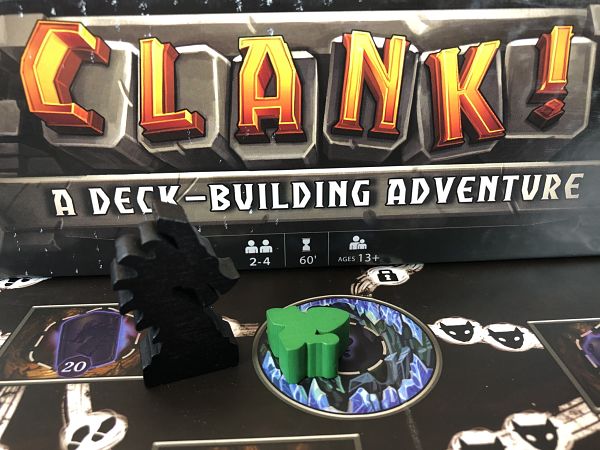
Clank! A Deck-Building Adventure is a deck-building, dungeon crawling (sort of) adventure in which players build their deck to provide movement, attach, and skill. These traits help characters navigate the dungeon in order to find—and collect—one of the dragon’s artifacts and return safely to the surface—along with any other treasures you may have pilfered along the way. Make too much noise and the dragon attacks! Get dealt too much damage and be lost in the dungeon’s depths for ever…unless those above can mount a rescue, of course.
But there is so much more to Clank! than just deck building and running around a dungeon. Let’s jump into some core factors of the game, shall we?
Immersion
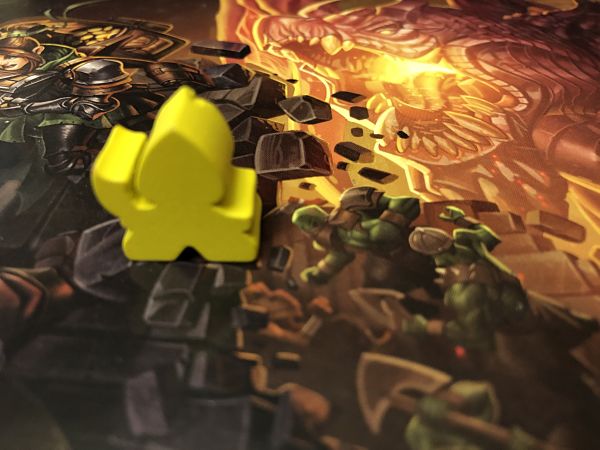
Starting with immersion is a natural place for me to start. I like a game that can consume me and make me forget about life’s troubles. I also like feeling immersed for entertainment purposes (much like movies and video games). That said, how does Clank! stack up?
It stacks.
I always have such a good time playing Clank! and its expansion, The Mummy’s Curse. I love being able to build my deck with unique cards that are quite thematic to the in-game world. The deeper into the catacombs I go, the bigger my feeling of dread that, somehow, I won’t make it back to the surface.
The basic story is simple enough: rob the dragon and get back out before you get incinerated. But the mechanics, art, and theme combine to make a compelling story that is weave by player actions. I have never played a game where all players weren’t bug-eyed stressed and laughing as we all try to loot and live. That, there, shows just how great the immersion is.
Oh, and the flavor text on the cards is brilliant.
Theme

The fantasy theme is strong with Clank!, with tropes of dungeons, dragons, and treasure integrated comically well that one can only wonder how this wasn’t a thing before now (at least, before 2016 when the game was first published).
The deck-building mechanic plays into the “leveling up” theme of fantasy adventurers, as you continually collect new cards that give you added advantages. And, each card is crafted to fit the theme perfectly, including abilities and flavor text.
It’s a strong theme made stronger with the gameplay.
Components
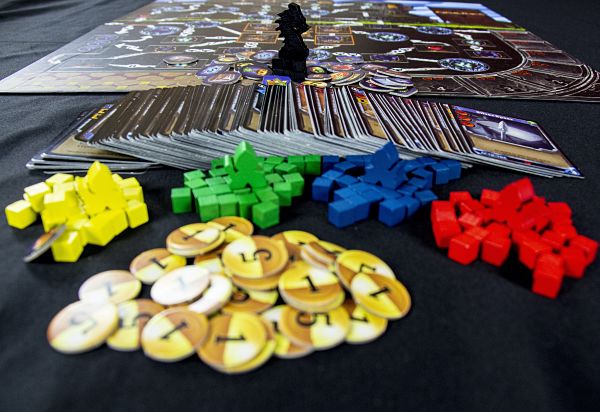
You’ve got the board, your character meeples, cardboard tokens of varying sizes and shapes, wooden cubes, and loads of cards. Everything is up to Renegade Game Studios’ standard for quality (for those unfamiliar with the company, that’s a good thing). Solid wood, sturdy cards and tokens, and a rule book that teaches the game with ease. Not much else to say about them other than they’re quality and won’t take away from your experience.
Standout Performances
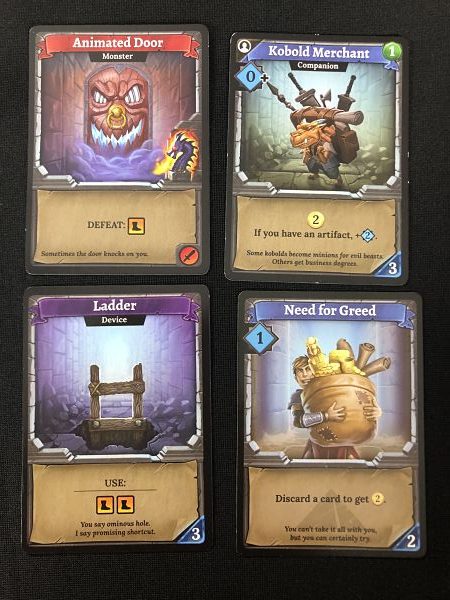
This is tough, because what don’t I love about Clank!? Although I love pretty much everything about the game, there are a few things that stand out to me as being what makes the game so stellar.
Flavor Text
Alright, so I know some people don’t spare flavor text a passing glance, but I love it. It brings you into the world of Clank! in a way not much else could. So when you play…read the flavor text!
Tension
The game feels like a race at the beginning, with each player trying to get the best prizes. But toward the middle of the game, the tension starts to ratchet up as players are producing more clank and taking more damage. After all, the more clank you make, the more cubes of yours go in the draw bag, and the better chance you have of taking a wound. Balancing your actions so you can risk wounds and still make it out alive gets more extreme as the game progresses, until you’re on a mad dash to the surface. And if someone makes it out while you’re still in the depths? Well, then you’ve got more to worry about, because that increases the end-game. I’m sweating in my seat just thinking about it!
Card Variety
There are heaps of cards in Clank!, and sooooo many are unique. In fact, you’ll be lucky to get through have the deck in one game! I like that because it makes you reevaluate your strategy as the game goes on—and as other players get the cards you were eying. A good shuffling will let you see new cards game after game after game.
Breaking the 4th Wall
In theater, breaking the fourth wall refers to when characters (or something else) directly address the audience, thus pulling them out of the narrative and making the astutely aware that they are, in fact, watching a performance and that’s it’s not actually real.
As I mentioned, I love practically all aspects of Clank!. But, there are a few things that could grind on the gears of some. While these don’t bother me, I feel like they are worth mentioning.
Player Elimination
Characters can die in this game. And while some folks don’t prefer player elimination in their games, Clank! mitigates its lackluster appeal by forcing the game to end sooner for all players once someone kicks the bucket. One someone dies, there are four rounds left, after which the game ends, regardless of who’s left. And that’s why I don’t mind player elimination in Clank!, because it adds even more tension at the end of the game.
In and Out
I love exploring the dungeon and collecting secrets and getting points in other ways. But, some people think it’s hilarious to go into the dungeon depths, grab the first artifact they can get to (which is inevitably worth fewer points than those further down), and rush to get back out. While this is a good strategy if you don’t have a lot of time in which to play, it can be fairly annoying to others (i.e. me) who want to experience the game as it was meant to be experienced, rather than racing to the finish. If all players are down, then why not! Go for it. But I’ve played in games where someone was in and out in record time, and it wasn’t as fun, most likely due to the tension not having time to grow. It was still fun, of course, but definitely not as engaging. Fortunately, I have only seen that happen with one other player (who will remain nameless…for now).
Gameplay Review

First Impressions
I will admit, I have owned Clank! A Deck-Building Adventure for a while now, so my first impressions are long forgotten. However, I do recall the buildup for buying it.
I wanted it so badly. I thought the theme looked fun, and play throughs I had seen showed nothing but things I wanted to play myself. When I first bought it, I remember my excitement at seeing everything in the box for the first time. More importantly, I remember the game being immensely fun the first time. I can’t give specifics, but there’s a reason I chose Clank! to be the first review on Board Game Immersion. That, and I already had a full short story written for it.
In short, I was not disappointed from the beginning, and it’s only gotten better.
Setup

Setup involves dealing out a starting hand of 10 cards to each player (each player starts with the same 10 cards; see rule book for more details on setup). The Mercenary, Explore, and Secret Tome cards are placed in three piles (one for each type) next to the board, along with the Goblin. These cards are always available for purchase (unless they run out) or, in the case of the Goblin, combat (the Goblin card always stays there).
Place the artifact tokens on their corresponding spaces on the board (face up). Shuffle around the Major and Minor Secret tokens and place one Major Secret token face up on each of the large question mark circles on the board, face down. Again face down, place two Minor Secret tokens on each small question mark space on the board.
Place the three Market Items (keys, backpacks, and crowns) on the market area. Place the three Monkey Idol tokens on their spots in the monkey shrine space. Place the Mastery tokens (worth 20 points each) above the board (these are for players who make it out alive).
Place money off to the side and then shuffle the Dungeon Deck. Shuffle it well, because there are a lot of cards, and you’ll want a good spread of things. Deal, in a row, six Dungeon cards. These are up for grabs during the game. Place the dragon marker on its place on the Rage track, according to the number of players. Place the 24 black dragon cubes in the bag.
Player pawns start outside the dungeon. Decide who goes first. That player places 3 Clank! cubes of their color in the Clank! area, the next player places 2 of their Clank! cubes in the Clank! area, and players three and four each place one.
Thoughts on Setup
While it may look like there are a lot of steps, setup is fair straightforward. The board is laid out so that it’s easy to know where tokens are placed (just match them up). Each player starts with the same 10 cards, so there is no question about who is different at setup.
There are a lot of cards, though, so you may want to enlist the other players to help shuffle while you set the rest up. Still, it’s not too bad, and if you have help, it’s even better. All in all, I don’t mind the setup process. Having played it many, many times, it doesn’t take me long, and I don’t even have to reference the rule book. It shouldn’t take you long to get to that point as well.
Gameplay
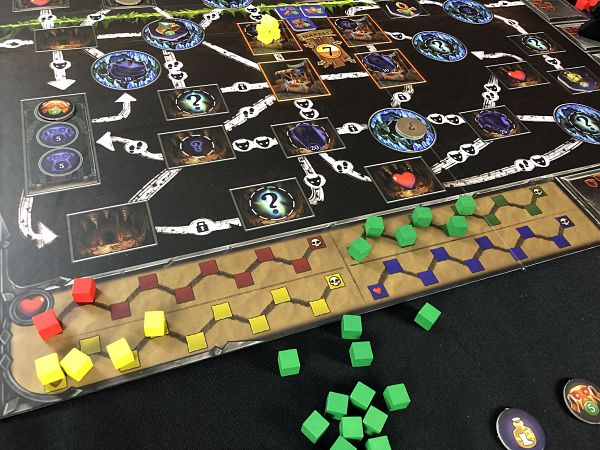
To start off, you must know your goal. That is, to grab an artifact and make it back out alive. By default, you can only carry one artifact (there are ways to carry more). Of course, everyone plans to come out with an artifact, so you’ll want to accumulate more points through tokens and cards as you adventure.
The General Gameplay
To meet your objective, you’re going to need skill. What good is a thief without skill? Skill is represented by the blue diamond with a number on it on your cards. That shows how much skill you have. You’ll be playing all of your cards from your hand each turn, so you can combine all the skill from your hand to make purchases. You can see a card’s cost by the blue corner (lower right) with a number in it. If you have sufficient skill, you can acquire it. Just like most deck-building games, put the newly acquired card on top of your discard pile. If you have more skill to spend (lucky you!), you may buy another card, if you can afford it.
At the end of your turn, draw five more cards. If your deck is out, shuffle your discard pile and then continue to draw up to five.
What are Cards Good for, Anyway?
Playing cards is where the adventure happens, and there are multiple things your cards can gain you:
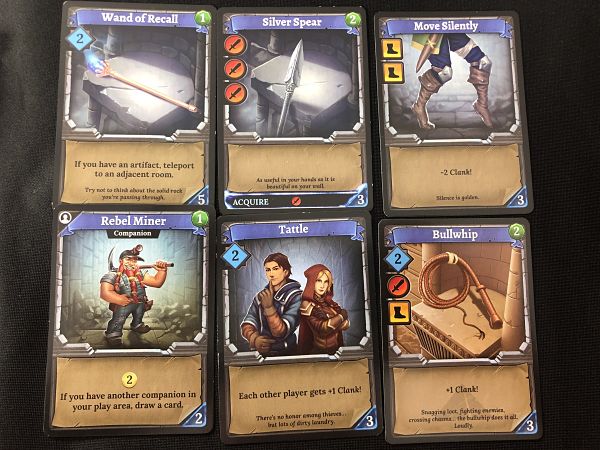
- Skill
- Swords
- Boots
- Gold
- Clank!
- Other bonuses (not that Clank! Is a good thing…)
We’ve already talked about skill. Your swords represent your attack power. You can attack monsters (i.e. the Goblin or other monsters in the Dungeon row of cards) or use them to protect yourself as you scurry through the dungeon’s dark passageways. To fight a monster, you must have at least the same amount of sword icons on your played cards that the target monster has (bottom-right corner). If you do, you defeat it and get the reward mentioned on the card. Some tunnels are infested with roaming monsters (as indicated by the monster face on a passageway). You may use one sword for each monster face in a passageway. You don’t have to—or you may not have that option—but if you don’t, you take one damage for each monster face you don’t put a sword to. Damage is taken by putting one of your colored Clank! Cubes on the left-most open space on your health meter. If your health meter reaches the last spot, you die, and the end game is triggered.
Boots let you move from room to room. One boot equals one tunnel. Unless the tunnel has a pair of footprints on it, in which case you need two boots. Or you enter a crystal cavern—this makes you stop regardless of how many boots you played. Or, uh, if there’s a lot on the tunnel. You’re gonna need a key from the market. Also, at the sides of the dungeon are some passageways that have a pointing finger on them. You can wrap around the board and come out on the other side (to the other pointing, judgmental finger). Yup, just like you did playing Pac-Man!

A little more about movement. Whenever you enter a room, you may immediately pick up a secret there. If it’s a large, major secret, take it and keep it. There will be something special on the back that will help you. Some tokens are to be used immediately, some can be kept for later use. You’ll want to reference the rule book on your first game our two. When entering a room with a minor secret, take the top one and leave the other one there for someone else. Of course, you can leave the room and come back to pick it up, but you can’t get both without leaving the room first. Same thing goes with the monkey idols. Enter the room, pick one up. Simple as that. If you enter a room with a heart, remove one of your Clank! tokens from your health meter and return it to your supply. If you enter an artifact room, you don’t have to pick it up; after all, once you claim an artifact, you can never drop it (call it the dragon’s curse). And, you cannot leave the dungeon until you have one. So do be sure to get one before things get too cray cray. When you do pick one up, the dragon marker moves ahead on the Rage track by one. The further up the track it gets, the more dangerous its attacks become (we’ll get to that).
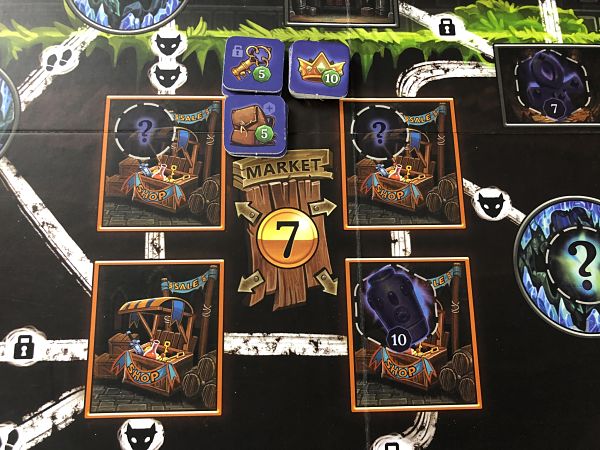
Gold lets you buy things from the market. You have to be on a market space to buy something, and everything is 7 bucks. Yup, for a junky old backpack to a king’s crown. Everything at the shop provides points, which is nice, since each gold is worth a point at the end of the game, so you’re not losing out too much. Crowns give you more points than what you paid, so those are always good. Keys allow you to pass through locked tunnels. The backpack lets you carry an extra artifact! Score!
If you get Clank!, you must place one of your colored cubes in the Clank! Area for each Clank! you get. This is bad news, because this is how the dragon attacks you (but, again, we’ll get to that).
And, of course, there are other things that can come from cards, such as giving other players Clank!, devices with abilities (that are a one-time use and do not go into your discard pile), and so on and so forth. Once your turn is over, draw five more cards from your deck. If your deck runs out, shuffle your discard pile and, as that is your new deck, continue drawing up to five cards.
The Dragon Mark

Refresh the Dungeon row from the Dungeon deck. If a card pops up that has the mark of the Dragon on it, the dragon attacks. If multiple appear, it still only attacks once (thank the Heralds!). To do a dragon attack, place all of the Clank! cubes from the Clank! area into the bag. Then draw out as many cubes as there are markers on the dragon’s space. If a black cube is drawn, set it aside and nothing happens. If a colored cube is drawn, it is placed on that player’s health meter. The Dragon is reborn as the Wheel deck wills it, so it can be a risk at times, not knowing if you’re going to get an attack at the end of your turn. Sometimes its best to leave the Dungeon row alone until you can heal (not that your opponents will, but buying even a little time can be a matter of life and death).
Escape (or Die Trying)

Remember, you cannot leave until you have an artifact. Heck, you can’t even score points if you don’t have an artifact. Yes, looting absolutely everything is some serious fun, but if you don’t get an artifact…what’s the point? Think about the mission!
Once you have an artifact in your possession, it’s time to high tail it out of the depths—the darker part of the game board (under the grass line)—and make your way to the surface. If you die in the depths, you die. Done for. No score for you. If you “die” above the depths (but still haven’t made it out), you are close enough for the locals to mount a rescue and save you. You keep your treasures, but you don’t get the 20 points from the mastery token. If you make it back out and to the surface before you die (good job!), you get a master token, worth 20 points.
But should you—or anyone else, for that matter—die…
Death is Lighter than a Feather Boot Lace…
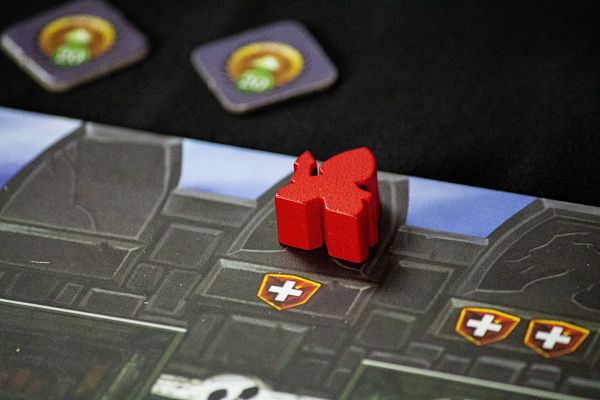
…everyone left living is in a heap of trouble. You see, when the first player dies (nobody else, mind), place their player meeple on the first space of the countdown track, at the top of the tower. On that player’s next turn, the meeple moves one space over and triggers a dragon attack—adding additional cubes drawn depending on the space that meeple is on. If the meeple reaches the fifth space, the dragon instantly KO’s all remaining players. Game over.
Scoring
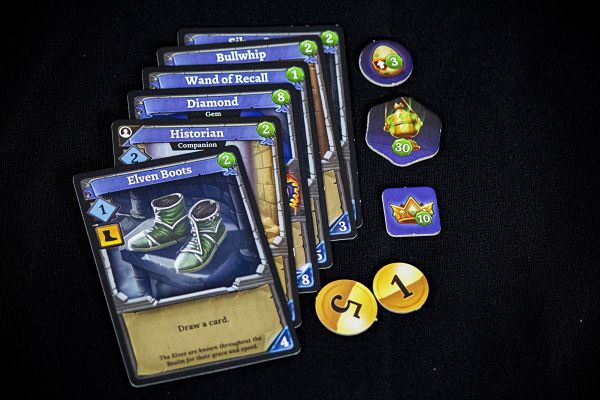
Any number in a green circle contest as points, plus any gold you may have (at a 1:1 scoring ratio). This means some of your cards will score you points, so don’t forget about them! Score points from:
- Your artifact(s)
- Other tokens
- Gold
- Cards
The player with the most points wins! In case of a tie, the player with the most valuable artifact wins. So don’t go cheap!
Thoughts on Gameplay

Wow! That’s a ton of explanation! But I find it’s important to know how a game plays before knowing if it’s up my alley or not. As you can see, there’s a lot going on in Clank!, and yet, it’s still pretty simple to grasp. Thankfully, you’re only playing five cards at a time (unless your cards allow you to draw more cards), so it’s pretty digestible for newcomers, and they’ll start getting the hang of things as their deck grows.
The damage and dragon attacks are what make this game as tension-filled as it is. Without that, it wouldn’t be the Clank! I know and love. Things start out nice and calm toward the beginning, but as players buy cards, more and more dragon attacks happen, and more and more damage gets taken. And, of course, the best artifacts are at the bottom of the dungeon, making it difficult to get to (what with perilous passageways and whatnot). And then there’s a matter of making it back out while still trying to collect treasure because Susie is already near the top with lots of gold and there’s no way you can compete with her if you don’t get at least one more monkey idol.
And then the dragon attacks, making you reconsider your last five turns.

Turns can go quickly, which helps up the game’s tempo. The natural progression from calm to maximum stress feels so good. The cards are so vast and varied that your strategy will be different than your opponents’ whose strategy will, in turn, be different as well. Cards come up just when you need them, producing glory and honor, while at other times they come a turn too late. It’s all about how you build your deck, along with a little element of push your luck (which I live for).
Gosh, I love Clank! A Deck-Building Adventure. There are a number of expansions as well, such as The Mummy’s Curse, which add new boards, new cards, and new happenings. I love the base game to death, but I love the variety the expansions bring as well.
Clank! is a game I will always love playing and will always recommend.
Solo Play

But wait! There’s more! Clank! is able to be played solo, thanks to a companion app from Renegade Game Studios. It’s a beat-your-own-score type of thing, but it also provides mini-missions throughout the game. I’m not always the biggest fan of a beat-your-score solo condition, but Clank! pulls it off nicely. I really enjoy this one solo. And, while, I know many people don’t particularly care for app-driven games, I like it a lot in this instance. The mini-missions add somme more depth to the solo game.
Final Verdict
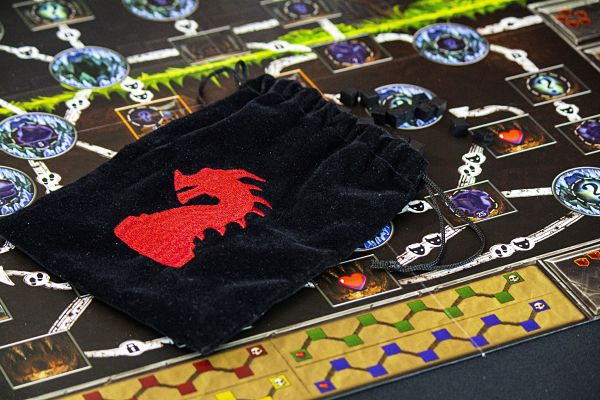
What’s left to say after all of that? In essence, I absolutely love Clank! A Deck-Building Adventure. It is tense, quirky, and deeply rooted in theme. The mechanics add to the theme and, as far as I’m concerned, everything is how it should be.
The narrative journey in itself is all kinds of fun. From the flavor text to the art and card names, everything helps immerse you in the game.
For my final verdict, I’m giving Clank! A Deck-Building Adventure a score of captivating. On the verge of standing ovation, even. I love it that much. I love writing about things I enjoy, so it’s little wonder that I chose Clank! to spearhead this new website. It’s an instant classic in every way.
I hope you enjoy it.
The Final Verdict is based on a scale of 1-7, although this scale is not numbered. Instead, it uses thematically appropriate words to describe the performance of the game, whether the game is thematic or not.
Verdict Scale (Lowest to Highest)
Tomatoes – This game was emotionally taxing and difficult to finish.
Uninspiring – This game had me daydreaming about other games.
Lackluster – This game had its moments, but it probably won’t see much table time.
Laodicean – This game is decent. It works. There’s a reason people like it.
Two Thumbs Up – This game is very good
Captivating – This game is outstanding! It’s more than good; it’s practically a staple.
Standing Ovation – This is the best game you will ever play. Period.
